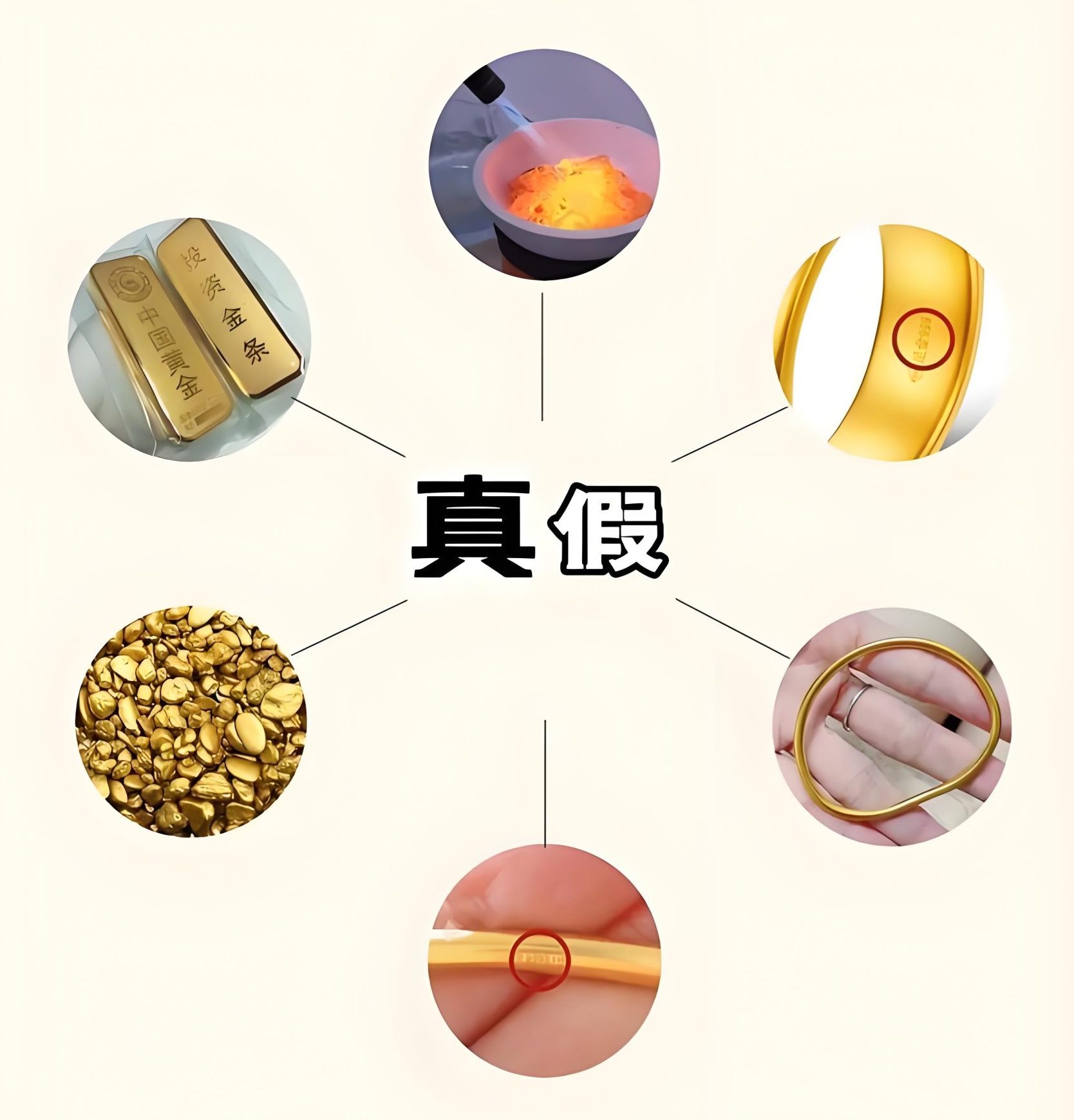In the fields of gold trading and jewelry appraisal, gold testers have become the “clairvoyant eyes” for discerning authenticity. As counterfeiting techniques become increasingly sophisticated (such as tungsten – wrapped gold and iridium doping, which are no longer distinguishable to the naked eye), scientific instrument testing has become the industry standard. This article will systematically analyze the six core technical means of professional gold testers for identifying the authenticity of gold and also provide simple self – testing techniques for consumers.


All gold testers are based on element fingerprint recognition technology, but the detection capabilities of instruments with different principles vary significantly:
| Detection Technology |
Applicable Scenarios |
Detectable Counterfeiting Methods |
Limitations |
| X – ray Fluorescence (XRF) |
Rapid screening of gold bars/jewelry |
Gold – plating, iridium/tungsten doping, K – gold passing as pure gold |
Unable to detect deep – seated inclusions |
| Density Method |
Regular – shaped gold products |
Low – density doping (such as silver) |
Not suitable for hollow/embedded jewelry |
| Ultrasonic |
Detection of the internal structure of gold bars |
Tungsten – cored gold – wrapped |
Requires a coupling agent and is complex to operate |
| Laser – Induced Breakdown (LIBS) |
Analysis of coating thickness |
Nano – scale gold – plating |
Expensive equipment and requires professional training |
Data source: “White Paper on Precious Metal Detection Technology” 2024 edition
Step 1: Elemental Spectrum Screening
The XRF spectrum of genuine gold should show:
- Strong characteristic peaks of Au – Lα (9.71keV) and Au – Lβ (11.44keV)
- The content of impurity elements complies with the GB/T 18043 standard (such as Ag < 0.1%, Cu < 0.2%)
Typical Case: In the “iridium – doped gold” case seized by Shenzhen Customs in 2023, the gold tester detected an abnormal iridium – Lα peak at 10.64keV, uncovering the counterfeiting method of doping 5% iridium.
Step 2: K – Value Consistency Verification
Use the instrument to measure the fineness of gold (such as 999‰) and compare it with the laser – engraved mark. A well – known brand once found that a batch of “AU999” gold bars actually had a purity of only 983‰, with a deviation exceeding the ±1‰ range allowed by the national standard.
Step 3: Coating Analysis Mode
When the coating detection function is activated, genuine gold products should show:
- Surface Au content > 99.6%
- Coating thickness is 0 (solid gold has no coating)
If a 2 – 5μm gold coating is detected and the base is copper/silver, it is a common gold – plating counterfeiting.
Step 4: Density – Related Verification
High – end gold testers (such as Hitachi EA600VX) can calculate the theoretical density simultaneously:
Density of genuine gold = 19.32g/cm³ (25℃)
When the detected density ≤ 18.5g/cm³, it may be doped with heavy metals such as tungsten/platinum.
Step 5: Micro – Homogeneity Test
Select three different parts of the jewelry (such as the clasp, link, and pendant) for testing. The compositional difference of genuine gold in each part should be < 0.3%. In a certain case, counterfeiters were found to use genuine gold at the clasp and copper alloy in other parts, creating “two – faced gold”.
Step 6: Database Comparison
Compare the test data with the standard substance database. Regular manufacturers’ gold testers (such as Oxford X – MET8000) pre – store more than 200 common gold alloy formulas and can automatically mark abnormal components.
- Magnet Test Method: Genuine gold is completely non – magnetic, but note that some counterfeits use non – magnetic metals (such as tungsten).
- Density Comparison Method: Measure with an electronic scale and a water cup. The density of genuine gold should be ≥ 19g/cm³ (with an error of ±0.5).
- Acid – Point Test: Drop nitric acid at an inconspicuous place. Genuine gold has no reaction (only applicable to K – gold detection).
Risk Warning: 80% of “household gold testers” on the market have insufficient accuracy. Sampling inspections on an e – commerce platform show that the misjudgment rate of devices under 300 yuan is as high as 47%. It is recommended to choose a professional institution for important detections.
1. Nano – Gold – Plating Technology:
- Feature: The coating is only 50 – 100nm, and traditional XRF may misjudge.
- Solution: Use a gold tester equipped with a micro – area analysis function (such as Hitachi EA3000X, with a minimum spot of 10μm).
2. Gradient – Doped Gold:
- Feature: The surface gold purity is normal, but the inside is doped with iridium/tungsten.
- Solution: Require equipment that can detect deep – seated elements (such as the depth analysis mode of the Olympus DELTA series).
3. Composite Material Jewelry:
- Feature: Only the contact surface is gold, and the inside is filled with cheap metals.
- Solution: Use multi – angle detection (such as scanning the upper and lower surfaces + sides).
- Element Detection Range: Include at least key elements such as Au, Ag, Cu, Pt, Pd, Ir, W.
- Detection Depth: High – quality equipment should be able to analyze up to 50μm below the surface (to deal with gold – plating counterfeiting).
- Calibration Certificate: Must provide a calibration report from the National Institute of Metrology (NIM).
- Software Function: Need to have an “automatic alarm” function that immediately alerts when common counterfeiting formulas are detected.
The actual workflow of the designated testing center of the Shanghai Gold Exchange:
- Preliminary Screening: Rapid XRF testing (60 seconds per piece)
- Re – inspection: Suspected samples are sent to ICP – MS (Inductively Coupled Plasma Mass Spectrometer)
- Arbitration: The fire assay method (destructive testing) is used for disputed samples
The entire process takes about 2 hours and costs 300 – 800 yuan per piece.
Rights Protection Case: In 2024, a consumer in Hangzhou detected that the “pure gold bracelet” purchased was actually 750 gold through a professional gold tester and finally received triple compensation. The court accepted the CMA – certified test report as key evidence.
Special Reminder: According to the “Administrative Measures for Precious Metal Trading”, it is illegal for merchants to refuse to provide the test results of professional instruments. Consumers can file a complaint with 12315.
By mastering these scientific testing methods, you can, like a professional appraiser, see through the mystery of the authenticity of gold. In the gold field where every gram matters, a truly wise investment starts with choosing the right testing tool.





发表回复